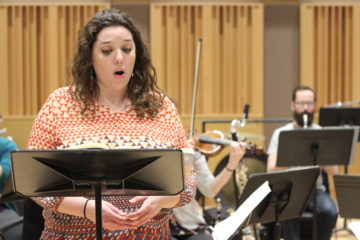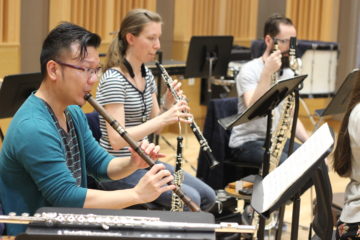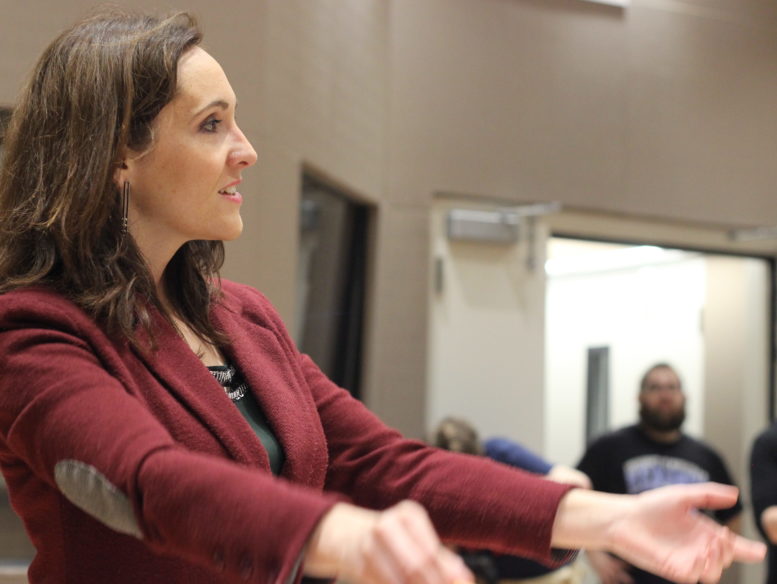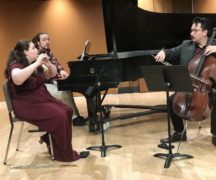By DAVID DUPONT
BG Independent News
In “Das Lied von der Erde (The Song of the Earth)” the composer Gustav Mahler tried to trick fate.
Diagnosed with a health ailment, and emotionally reeling from the death of his eldest daughter, he didn’t want to write what would be his Ninth Symphony. For other composers the ninth symphony was their last.
So he wrote “The Song of the Earth,” a six movement work of symphonic proportions, but didn’t call it a symphony, said Bowling Green State University musicologist Eftychia Papanikolaou.

Laura Reaper
The piece also called for a large orchestra so was difficult to perform. But in the early 20th century a group of Viennese musicians including Arnold Schoenberg decided this work should be performed more often. So a reduction of the score for 14 musicians was created.
Conductor Mercedes Diaz Garcia, a doctoral student at the College of Musical Arts, was drawn to the piece and decided that she wanted to present it to the Bowling Green community.
So she recruited the musicians and the two vocal soloists. They’ve been rehearsing the difficult hour-long work for weeks and will present it Wednesday, April 19, at 8 p.m. in Kobacker Hall on campus.
The project is an act of love for all concerned. Diaz Garcia can’t pay anyone, and the project is not part of her doctoral studies.
“‘The Song of the Earth’ is not about the physical earth but about the inner world, it’s about the depth of the human soul. So it’s very deep, it’s very exhausting,” the conductor said.
 For all its challenges she found musicians who are up to the difficult task and willing to take it on. “I think they are very interested to play this because it’s Mahler. Mahler for orchestral musicians is a huge challenge. It’s so intense and so emotionally powerful.”
For all its challenges she found musicians who are up to the difficult task and willing to take it on. “I think they are very interested to play this because it’s Mahler. Mahler for orchestral musicians is a huge challenge. It’s so intense and so emotionally powerful.”
And because of the small number of musicians, Diaz Garcia said. “Everyone’s a soloist so it’s very demanding and very exposed for everyone. That’s something musicians like.”
It gives them more freedom to express their concept of the music than being in a section playing the same part as other musicians, she said. And as a conductor Diaz Garcia sees her role as working with allowing musicians to have a say in shaping the music. “It’s not a dictatorship,” she said.
The piece is a large undertaking for all involved.
That includes the two vocal soloists mezzo-soprano Laura Reaper and tenor Moises Salazar. The two singers alternate movements, with Reaper singing the final movement that lasts a half-hour.
“It’s something you always wish to sing,” she said, “but it’s done so seldom.”
Papanikolaou will introduce the piece. The songs are based on Chinese poetry, loosely based given the German translations were done not from the original Chinese but from French translations.
 The title of the collection is “The Chinese Flute.” It’s fitting that the flutist Hong-Da Chin in the performance will incorporate traditional Chinese flutes as well as the Western flute. He said he’s played the two types of instruments since he started studying flute as a child.
The title of the collection is “The Chinese Flute.” It’s fitting that the flutist Hong-Da Chin in the performance will incorporate traditional Chinese flutes as well as the Western flute. He said he’s played the two types of instruments since he started studying flute as a child.
Mortality was much on the composer’s mind. The movements explore the joys and sadness of life with the final movement, “Farewell,” “transports us into the afterlife,” Papanikolaou said.
The work ends with the mezzo-soprano intoning the German word for farewell, over and over. The final chord, though, never quite resolves. “There’s a suspension you feel at the end of this composition,” Papanikolaou said.
And Mahler thinking he had avoided the curse of the ninth symphony died as he was writing what was really his 10th symphony.
Diaz Garcia is a native Spain. After two years of learning singing, she took up oboe at age 9. She’d seen the instrument in an Italian movie and fell in love with it. A year later she started playing piano.
By the time she was 23 she was already teaching oboe in a conservatory in Madrid. But oboe and piano did not satisfied her musical urges.
“I had so many interests about music, so many questions,” she said “Somehow it seemed like it was not enough to play oboe, not enough to play piano.”
Conducting gave her the ability to work with musicians and shape the sound. She studied throughout Europe before attending Bard College in New York’s Hudson River Valley to study conducting. She also studied conducting at the University of Cincinnati.
Diaz Garcia said she realized that to succeed she needed to find something that would set her apart. While visiting a friend in Oberlin, she saw a poster for the Doctorate in Musical Arts in Contemporary Music at BGSU.
Diaz Garcia had already conducted contemporary music at Bard and saw this as a way of distinguishing herself.
In her two years at BGSU she has worked with Emily Freeman Brown and taken classes in contemporary music.
Diaz Garcia said she especially loves the connection between the conductor and the soloist in a concerto. In the past two years, she’s been called upon to conduct the most difficult works on the concerto concert featuring the winners of the Competition in Musical Performance.
In 2016 she conducted Witold Lutoslawski’s Concerto for Piano with Zach Nyce as soloist. This year she conducted Joan Tower’s Flute Concerto with Kenneth Cox as the soloist.
Beyond BGSU, Diaz Garcia has set her sights on a conducting career, though she knows the current climate is not good for those invested in the arts “or for foreigners, anywhere in the world,” she said. “But this is what I love doing.”
The orchestral performers are: Hong-Da Chin, Chinese flutes, flute, and piccolo, Jana Žílová , oboe and English horn, Derek Emch, clarinet and bass clarinet, Alex Meaux, bassoon, Garrett Krohn, horn, Teresa Bellamy and Brandi Main, violins, Kathryn Kibbe, viola, Jonathan Moody, cello, Jenica Georgeson, bass, Kevin Bylsma, piano, Robert Ragoonanan, harmonium (keyboard), and Scott Charvet and R. J. Seibert, percussion.





